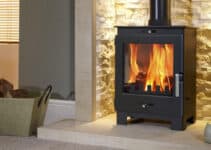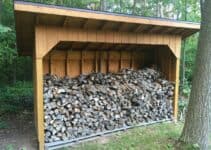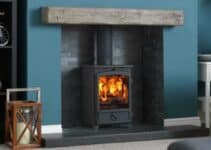When I embark on the journey to distinguish the difference between a log burner and a wood burner, it’s intriguing to note that these terms are often spoken of colloquially as if they are synonymous. Delving deeper, however, reveals a striking variance not only in their design but also in their operational dynamics and the type of cosiness they impart within a home. Whether it be the robust wood burning stove or the versatile log burning stove, the subtleties between the two are worth understanding for anyone contemplating the warmth of a log burner vs fireplace.
Foremost among these distinctions is the stringent specificity of fuel utilised by a wood burner—a commitment to exclusively incinerating wood logs within its chamber. Such commitment ensures an efficient, tar-free burn, provided the timber is suitably dry and seasoned. The complexity increases with multi-fuel or mineral-fuel stoves—commonly labelled log burners—engineered to embrace a broader palette of solid fuels, including smokeless coal, necessitating an intricate ash management system to maintain vitality and heat output. As a connoisseur of artisanal domestic warmth, I appreciate the craft embedded within each design and aim to offer insights valuable to my discerning readers who are weighing wood burner vs fireplace options.
Understanding the Fundamentals of Wood Burners and Log Burners
As I explore the core definitions integral to comprehending the choice between wood burner or log burner, it becomes evident that while some may use the terms interchangeably, pivotal distinctions in design and functionality set them apart. Grasping these differences is essential when looking at a wood burner vs fireplace or a log burner vs fireplace, as each offers unique advantages and limitations within a domestic setting.
Defining Wood Burners: The Basics
When we speak about the wood burner definition, we’re referring to appliances explicitly designed for burning wood logs. Built with a solid floor base, wood burners function optimally by accumulating and maintaining a bed of ash, essential for the wood’s combustion process. Unlike fireplaces or alternative solid fuel stoves, they lack an ash pan, requiring only occasional clearance of excess ash. The performance of a wood burner correlates directly with the care taken in selecting and preparing the wood, where well-seasoned logs are not just preferable but necessary for efficient and safe operation.
Characteristics of a Log Burner
On the other hand, the log burner definition includes stoves that harness the versatility to burn multiple types of fuels by leveraging a grate for enhanced airflow from beneath, a requisite for burning coal. The term ‘log burner’ often segments into what are known as multi-fuel stoves, where the operative term ‘multi-fuel’ underlines their capacity to oscillate between wood, smokeless coal, and other solid fuels. Notably, these stoves demand regular ash disposal to maintain optimal functionality. The difference in the kindling and combustion processes is significant between a wood burner and log burner, each influencing the overall heat output and user experience.
To summarise, while both wood burners and log burners can be central features in creating a warm and inviting home atmosphere, they serve distinct purposes and require different approaches in terms of operation and maintenance. Understanding these subtleties is crucial to making an informed decision about whether a wood burner or log burner aligns better with your lifestyle and heating preferences.
Core Differences Between Wood Burners and Log Burners
As someone deeply interested in sustainable heating, I find the distinction between wood burners and log burners not only intriguing but essential for homeowners considering an eco-friendly heating solution. Understanding the specific differences aids in making an informed decision that aligns with one’s lifestyle and heating needs.
The Grate and Ash Pan Dilemma
When contemplating the merits of a wood burning stove vs a log burning stove, the presence of a grate and ash pan in the latter often becomes a focal point of discussion. A wood burner, by definition, is tailored for burning logs on a bed of ash, enhancing the wood’s combustibility and reducing the necessity for frequent ash removal. However, a log burner or multi-fuel stove offers the flexibility to burn other fuels, such as smokeless coal, which necessitates a removable ash pan for user convenience during the ash disposal process.
Fuel Burning Efficiency and Restrictions
The debate between log burner or wood burner efficiency hinges on fuel usage. My observations indicate that wood burners are highly efficient when lighting seasoned wood but are not suitable for burning coal due to their design constraints. Conversely, log burners accommodate a broader range of fuels, necessitating a multi-fuel capable design that includes features for efficient air circulation and ash management.
Physical Construction Distinctions
The physical construction of a stove is intrinsically linked to its intended fuel, and in the context of a wood burner definition versus a log burner definition, the contrast is evident. The simplicity of wood burners is marked by their lack of grates and ash pans, which suits their singular fuel type. Log burners, in contrast, feature a more complex construction with additional components to support the combustion of various fuels, reflecting one of the fundamental differences between a log burner and a wood burner.
Evaluating Performance and Maintenance Considerations
When delving into the realm of home heating and stoves, individuals often weigh the pros and cons between a wood burner and a log burner. These considerations are not merely about aesthetics but pivot on performance, efficiency, and maintenance demands. In my experience, understanding these factors is crucial for anyone looking to make an informed decision fitting both lifestyle and environmental consciousness.
Heat Efficiency: Wood Burner vs Log Burner
The debate between the heat efficiency of a wood burner vs a log burner is one influenced by numerous variables. A wood burning stove’s commendable heat efficiency is predominantly hinged on the type of firewood used; it must be well-seasoned to burn effectively and sustainably. Conversely, log burners, or multi-fuel stoves, accommodate a variety of fuels but with varying degrees of efficiency. Such stoves offer the flexibility of burning smokeless coal in addition to wood, thereby providing an alternative in zones where wood-burning may be restricted due to smoke regulations.
Longevity and Performance Optimisation
My observations underscore the reality that the longevity of a stove is intrinsically linked to how it’s used and the consistency of the fuel. A wood burning stove vs a log burning stove presents a longevity variance, largely due to the maintenance routines each requires. Adherence to manufacturer guidelines and consistent use of recommended fuel types can significantly prolong the life and efficiency of any stove, whether it’s a dedicated wood burner or a versatile log burner.
Maintenance and Care for Different Stove Types
In the context of maintenance, there’s a distinct divergence between the needs of a wood burner and those of a log burner. With a wood burner, the aim is to maintain a nourishing bed of ash, thereby reducing the frequency of ash removal. In contrast, log burners necessitate more regular clearing out of the grate and ash pan to thwart any obstructions to proper airflow. Such maintenance is not burdensome but remains a critical aspect of care for ensuring optimum performance.
Deciding between a wood burner or a log burner often boils down to the specific needs of the homeowner. Each type presents a set of attributes that cater to different preferences, whether one prioritises the carbon-neutral benefits of wood burners or the fuel flexibility of log burners. In the end, my advice to readers is to ponder the balance between performance efficiency and ongoing maintenance to choose a heating solution that aligns with both their environmental stance and lifestyle convenience.
Design Aesthetics and Home Integration
As a dedicated advocate of bespoke home design, I recognise that the decision of whether to integrate a log burner versus a wood burner extends far beyond their functional disparity. When considering the difference between a log burner and a wood burner, the impact on your home’s aesthetics is colossal. The timeless elegance of a wood burning stove dovetails effortlessly with both modern and traditional decor, radiating warmth and adding a hint of nostalgia. Opting for a wood burner vs a fireplace cultivates a particular charm, reminiscent of yesteryear yet capable of anchoring a contemporary living space with its dignified presence.
The appeal of a log burning stove lies in its versatility. Despite being similar in appearance to its wooden counterpart, a log burner can comfortably nestle into a multifaceted array of interior designs and is well-suited for smoke control areas when appointed with smokeless fuels. My professional insight aligns with eco-conscious homeowners who may tilt towards wood burners for their sustainable, carbon-neutral footprint. Conversely, the corresponding robustness and adaptability of a log burner vs fireplace become deciding factors for those who seek the freedom to switch between different types of solid fuels.
Ultimately, the tug-of-war between a wood burner and a log burner in the context of home integration boils down to personal taste and practical requirements. Whether faced with the wood burning stove vs log burning stove conundrum, I believe it’s essential to blend functionality with a personal aesthetic vision, ensuring that the heating solution chosen not only complements but enhances the overall atmosphere of the home. In the vast lexicon of interior styling, these stoves are not merely appliances but vital components of the narrative that makes a house a home.



